American Religion 美国宗教发展历程
- 格式:doc
- 大小:64.00 KB
- 文档页数:17
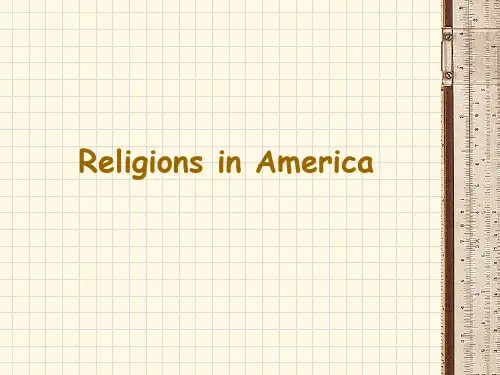
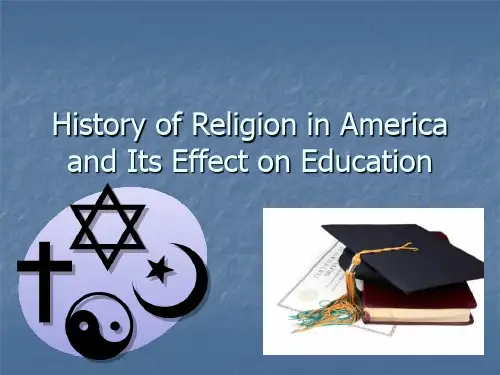

美国宗教概况摘要:美国的宗教历程即移民历程。
关键词:移民,转变,信仰,教派如浪潮般涌来的新移民,加上国内的演变,使美国的宗教构成发生了大转变,出现了五花八门可供选择的信仰,变化之大和信仰之多,令他国望尘莫及。
对过去两个世纪的简短回顾显示了这一点,而未来这一趋势将有增无减。
1776年对美国宗教团体的一次调查发现,源于英国的团体占主导地位。
对比不应大惊小怪,因为早期移民大多是英国人。
人数最多的教派为公理会,长老会、浸礼会、新教圣公会和公谊会。
到1850年,移民和国内福音传教活动带来了许多变化。
当时,有一个宗教团体,即卫理公会,拥有的信徒占美国人的三分之一以上。
它从1776年的第9位爬至1850年的第1位,这主要归功于福音传教活动。
加入浸礼会的美国人约占美国总人口的21%,天主教徒约占14%,从1776年的第10位升至1850年的第3位,主要是由于移民的到来。
长老会仍占 12%,但已出现了缓慢下降的趋势。
公理会教徒人数下跌,仅占4%,新教圣公会降至3.5%,教友会则更是远远落在后边。
到1890年,前 4个团体的位置再次发生转换。
天主教首次以730万成员(包括儿童)占据了首位,从那时起,他们一直保持这一地位,而且,如果排除新教团体出现大合并的情况,他们将一直雄居首位:卫理公会以710万之众紧随其后,浸礼会590万,而长老会为190万。
35年后的1925年,浸礼会教徒自称他们将永远是美国最大的新教教派。
他们的势头上升,既由于白人浸礼会教徒增加,也由于黑人浸礼会团体的人数大增并形成组织。
主要由白人组成的南方浸礼会虽然名为“南方”,但却代表了50个州的教徒,多年来不仅是最大的浸礼会团体,而且是美国最大的新教教派。
新教的世俗化:福音会的崛起美国值得注意的是,不仅其宗教五花八门,而且信徒极为虔诚,这对基于欧洲经验,认为社会越进步,工业化程度和技术水平越高,便越世俗化的社会学理论提出了挑战。
美国革命时期,常去教堂作礼拜的美国人约占17%。
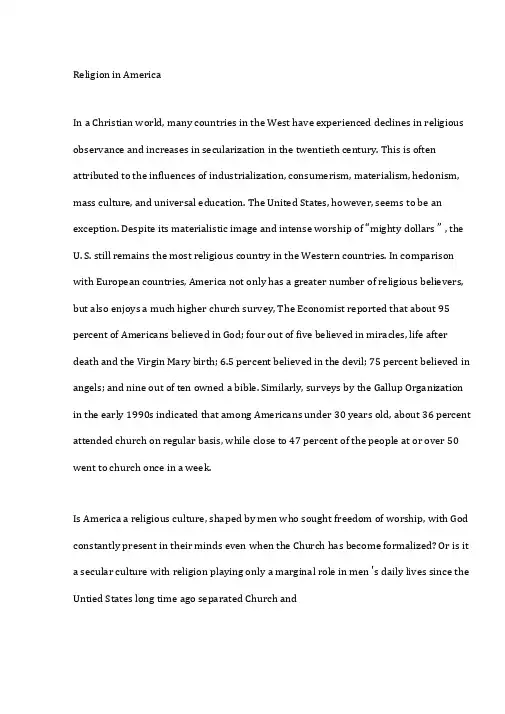
Religion in AmericaIn a Christian world, many countries in the West have experienced declines in religious observance and increases in secularization in the twentieth century. This is often attributed to the influences of industrialization, consumerism, materialism, hedonism, mass culture, and universal education. The United States, however, seems to be an exception. Despite its materialistic image and intense worship of “mighty dollars ” , the U. S. still remains the most religious country in the Western countries. In comparison with European countries, America not only has a greater number of religious believers, but also enjoys a much higher church survey, The Economist reported that about 95 percent of Americans believed in God; four out of five believed in miracles, life after death and the Virgin Mary birth; 6.5 percent believed in the devil; 75 percent believed in angels; and nine out of ten owned a bible. Similarly, surveys by the Gallup Organization in the early 1990s indicated that among Americans under 30 years old, about 36 percent attended church on regular basis, while close to 47 percent of the people at or over 50 went to church once in a week.Is America a religious culture, shaped by men who sought freedom of worship, with God constantly present in their minds even when the Church has become formalized? Or is it a secular culture with religion playing only a marginal role in men 's daily lives since the Untied States long time ago separated Church andState? To answer these two questions is no less than looking into the dynamics of American culture and the complexity of American society. The fact of the matter is that each of these questions can be answered affirmatively. America is as secular as a culture can be where religion has played an important role in its origins and early growth, and has been interwoven with the founding and meaning of the society. America is also as religious as a culture can be whose life goals are worldly and whose daily strivings revolve not around God but around Man.God and ManThe mixture of theocracy and secularism is actually one of the American religious heritages. One can find the strong religious base of American life and thought in the older Puritan communities of New England and in the new frontier states. The Calvinist doctrine of predestination, for example, played a dominant role in the early colonists. People moving to the frontiers in the West were mostly inspired by the vast stretch of land available for attainment. They dreamed of getting rich quick, and at the same time tried to comfort their souls by waging religious revivals there. At the time Americans embraced Enlightenment ideas and applied them in their political, social and economic life, they still constantly referred to the Holy Scripture for conviction and reassurance. Even in the contemporary Atomic Age where science and technology has developed to an unprecedented level, there has been an activerevival of religious feeling among the American people, old and young, in modern cities. To a certain degree, this mixture of 17th-century rationalism (Science and Technology),and mid-20th-century revival may help explain some of the contradictions in the relations between God and Man in America. America is regarded as a “ Christian countinryfluence” o.f TJuhdea ic-Christiandoctrines upon American culture has been profound. For example, the religious doctrine of the soul is so crucial and pervasive in Western (including American) conceptions of man that no one would deny that Judaic-Christian doctrine is a major element in shaping American national character and culture. In the minds of American Christian believers, the idea that man has a soul and that all souls are “ equabl efore God”has been basic to the ethical evaluation of individual personality. The idea of the worth, dignity, and inviolability of the individual unquestionably owes much to this belief, as do humanitarian ideas and various philosophies of human equality.Historically speaking, the whole idea of God and individual soul goes back to the sixteenth century. As the child of the Reformation, Americans took over not only its dominantly Protestant heritage, but also its deep individualistic strain. Every European sect that had found itself constricted or in trouble emigrated to the New World, which thus became a repository of all the distillations of Reformation thought and feeling. Since the Reformation had broken with the authority of the Roman Catholic Church and left to the individual meaning of the Scripture, America became a congeries of judging individuals, each of themweighing the meaning and application of the Word. A Bible-reading people emerged, drenched in the tradition of the Old and New Testaments. This may help explain the stress on the idea of “ covenant withc aGno tdhoug”ht. inAmeriIt also suggests why a people so concerned with the meaning of the Holy Writ have been the first to give a sacred character to a written Constitution but at the same time remain a nation of amateur interpreters of the Constitution.Two basic concepts of the Christian —the soul and sin—took on a new emphasis in individualist America. Each man was the judge of his own religious convictions, since his possession of an immortal soul gave such an inner worth regardless of color, rank, or station, political belief, wealth or poverty. Thus, the foundation was laid for religious freedom early on in the Untied States. On the other hand, if each man had an immortal soul to save, it was because it had been steeped in sin. As a Bible-reading people, Americans took over many of the preconceptions of the Hebraic society in which Judaism and early Christianity were rooted. Among them was the sense of individual sin—aside from original, or inevitable sin—without which there could be no individual salvation.There is a resulting ambiguity between the sin-and-salvation strain in Christian doctrine and the organic optimism of American economic and social attitudes. The Hebrew prophets, as they lamented the disintegration of Biblical society, called on each Jew to ward off God' sw rath from his people by cleansing himself of his own inner guilt; the Christian allegory added to the somberness of this conception. But there have been few occasions on which Americans could believe with any conviction in an impending collapse of their social structure and their world. The sense of sin and the sense of doom were therefore importations from the Old and New Testaments that somehow floweredin the American soil in spite of worship of money and success, or, perhaps, exactly because of this worship, for in this case, it required a compensating doctrine to ease the conscience.The result has been an American religious tradition which is on the one hand deeply individualistic, anti-authoritarian, and concerned with sin and salvation, and yet, on the other hand, secular and rationalist in its life goals, and concerned with happiness in this world. Americans, growing up in this religious tradition, have been salvation-minded, each believer engrossed in his relation not to the church but to God, in Whom he was to find salvation. At the same time, they have also formed a secular rather than a sacred society, in which everybody pursued his earthly comforts according to his own conscience。
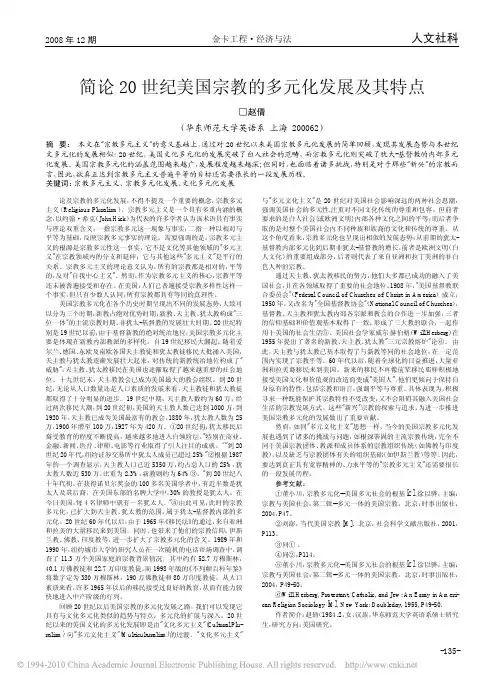
简论20世纪美国宗教的多元化发展及其特点□赵倩摘要:本文在"宗教多元主义"的意义基础上,通过对20世纪以来美国宗教多元化发展的简单回顾,发现其发展态势与本世纪文多元化的发展相似:20世纪,美国文化多元化的发展突破了白人社会的范畴,而宗教多元化则突破了犹太-基督教的内部多元化发展。
美国宗教多元化的涵盖范围越来越广,发展程度越来越深;但同时,也面临着诸多挑战,特别是对于那些"新兴"的宗教而言,因此,欲真正达到宗教多元主义普遍平等的目标还需要很长的一段发展历程。
关键词:宗教多元主义、宗教多元化发展、文化多元化发展(华东师范大学英语系上海200062)论及宗教的多元化发展,不得不提及一个重要的概念:宗教多元主义(Religious Pluralism)。
宗教多元主义是一个具有多重内涵的概念,以约翰・希克(John Hick)为代表的许多学者认为该术语具有事实与理论双重含义:一指宗教多元这一现象与事实;二指一种以相对与平等为基础,反映宗教多元事实的理论。
需要强调的是:宗教多元主义的根源是宗教多元性这一事实,它不是文化等其他领域的"多元主义"在宗教领域内的分支和延伸;它与其他这些"多元主义"是平行的关系。
宗教多元主义的理论意义认为,所有的宗教都是相对的,平等的,反对"自我中心主义"。
然而,作为宗教多元主义的核心,宗教平等还未被普遍接受和存在。
在美国,人们已普遍接受宗教多样性这样一个事实,但只有少数人认同,所有宗教都具有等同的真理性。
美国宗教多元化在各个历史时期呈现出不同的发展态势,大致可以分为三个时期:新教占绝对优势时期,新教、天主教、犹太教构成"三位一体"的主流宗教时期,非犹太-基督教的发展壮大时期。
20世纪特别是19世纪以前,由于基督新教的绝对统治地位,美国宗教多元化主要是体现在新教内部教派的多样化。


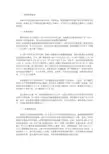
一、美国宗教现状1960年代是美国宗教历史的分水岭。
从那时起,美国宗教发生的最大变化是宗教多元化的发展,新教失去了自殖民地时期以来的主导地位,它与罗马天主教和犹太教成了三足鼎立的局面。
(一)新教的变化按照美国人自己的说法,在20世纪50年代之前,美国的文化模式是WASP,即“白人一盎格鲁一萨克逊新教’,因为来自欧洲的信奉新教的盎格鲁萨克逊人及他们的后裔掌握着控制美国政治和经济的权力,他们的文化价值观成了美国占统治地位的价值观。
至50年代之后,原先的W1SP模式开始逐渐被一种新的模式PCJ即卩“新教——天主教——犹太教”所取代。
从1960年代到90年代后期,新教主流派教会呈现萎缩的趋势,而保守派教会W则表现出迅速增长的势头。
其中,摩门教成员到1997年已达4923万人,比1983年增加了37%;神召会成员到1998年已达252.6万人,比1985年增长了27%;1998年,南方浸礼联会成员达15729万,是仅次于罗马天主教的第二大教会;基督上帝会成员到1991年已有550万,成为排在罗马天主教、南方浸礼联会、联合卫理公会及美国全国浸礼会之后的全美第五大教会。
历史上,保守派教会不太关心社会,只强调人的“灵魂拯救”和“得救重生”,因而在美国社会和政治中影响不大。
70年代后期,保守派一反常态,开始关注社会问题,积极参与政治活动,产生了不小的影响。
在新教发生巨大变化的同时,天主教和犹太教却获得了长足发展。
二战后,天主教徒平均收入水平和受教育程度有很大提高,从而使天主教摆脱了以前“穷人宗教”的形象,其信徒的社会经济地位大大上升,在美国人口中所占比例不断增高。
1999年,新教徒占全国人口的比例已下降为55%,天主教徒则上升至28%。
犹太教和天主教一样,也曾经饱受反犹主义之苦,但他们采取了内外双重效忠的立场来改善自己的处境,加上经济上的成功和为越来越多的人所接受,因此他们对美国产生了认同感。
同时,犹太教也积极适应美国的社会环境进行改革,使自身美国化,最终获得人们的认可,并成为美国新的宗教模式之一。

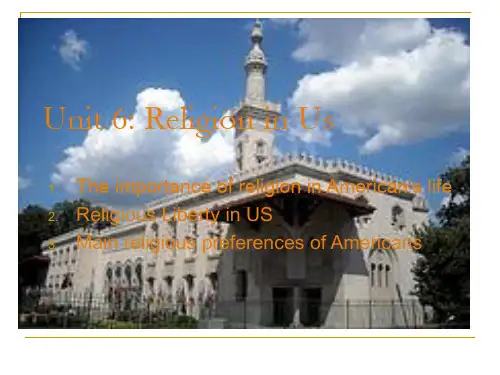
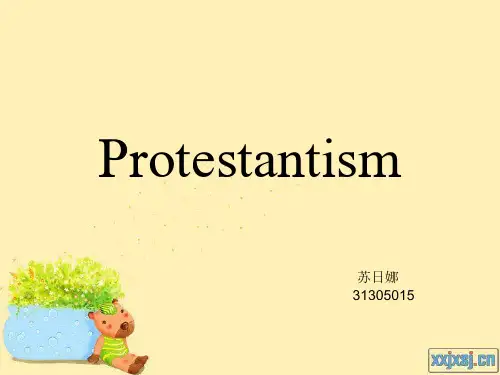
American Religious Culture美国是一个宗教色彩浓厚的发达国家,其宗教多元化与移民问题有密切关系,宗教信仰已成为美国文化和历史不可分割的组成部分,这种多元宗教文化的传统对美国的社会生活产生了深刻影响。
USA is a developed country with rich religious colors and its multi-religious features are closely connected with itsimmigrants. Religious beliefs are an inseparable part of American culture and history. This deep-rooted multi-religious culture has exerted great influenceon American lives.一、美国的宗教文化背America's religious and cultural background美国向以“民族熔炉”和“宗教联合国”著称。
America is famous as an "Ethnic melting pot" and "religious United Nations".美国人大部分是17和18世纪欧洲移民的后裔,另外,还从拉丁美洲、亚洲、澳洲、非洲甚至加拿大涌入了大量移民。
移民们持续稳定地涌入美国,带来了他们本国的文化和传统,从而使美国社会变得丰富多彩,也对美国多元文化的形成产生了深远的影响。
Americans are mostly descendants of European immigrants of17 and 18th Century. In addition to there are also a large number ofimmigrants from Latin America, Asia, Australia, Africa and Canada. Thesteady influx of immigrants brought their own culture and traditions to America. They make the American society rich and colorful and even impact far-reaching influence on the formation of America’s multicultural.多元文化的沃土滋养出了多元宗教文化。
美国的宗教信仰!本刊专稿作者:王坚中美两国还能互信吗?(一)美国的宗教信仰美国是一个高度宗教性质的国家,大多数人信仰基督教和天主教;同时,美国又是一个多民族的国家,国民大都来自海外移民,各个不同文化背景的移民带有各种不同的宗教信仰汇集到美利坚大地上。
美国国民主要信奉基督教和天主教,犹太教、东正教、佛教、伊斯兰教、道教等,其他的宗教门派亦有一定的信众教徒,信仰宗教的公民在美国总人口中约占91%。
每一种宗教有自己的教主“神”,神是高于一切的。
基督教的教主上帝耶稣,天主教主是天主圣父,伊斯兰教教主是真主安拉。
西方所有主要宗教的一个鲜明共识:只有自己的经典才是真理,而且放之四海而皆准,其他宗教的经典则属于歪理邪说;因为放之四海而皆准,信徒的责任,就只能是照本宣科而不得擅改一字,倘若修正一字便是弥天大罪。
基督教、犹太教、东正教、天主教是一神教,祟拜一个神灵;伊斯兰教继承借鉴基督教、犹太教,也是一神教。
西方的主要宗教全都遵循神统领那套路数,凭自我想象人为地创造出这么一个“一神教”的东西,统领信众。
所谓一神教,就是唯我独尊,唯我权威,其他皆为异端必须消灭,完全彻底的排他和不可包容。
西方三大宗教自己内部,会因各个教派不同而互相残杀,更何况异教徒,绝对的零容忍赶尽杀绝。
基督教(新教)在美国已有300多年历史。
1776年美国独立前,基督教(新教)的主要派别均已传入美国,其后迅速发展成为最有影响的宗教。
在美国宗教中,基督教(新教)教徒最多,约有1.56亿人,占美国总人口的57%。
主要有浸礼宗、卫斯理宗、信义宗、加尔文宗、圣公会、圣洁教会等,此外还有数十个较小的教派组织和跨教派的国际性的组织。
各宗派创办有400多所大专院校。
基督教已深入社会各领域。
天主教于1526年传入印第安人居住区。
1565年成立第一个团体。
1789年成立第一个主教区。
到19世纪中叶,有教徒300余万人,1914年增至1700万人。
目前为5800万人。
Chapter 4Religion in the United StatesI. American history and religious liberty---history―WASP‖(央格鲁撒克逊白人新教文化), which stands for ―White Anglo-Saxon Protestant‖, is believed to be the basis of the mainstream culture of the United States.-- Although the Church of England was an established church in several colonies, Protestants lived side by side in relative harmony.(英国国教虽然在几个殖民地是官立教会,但新教各派都能和平相处.) They had began to influence each other. The Great Awakening of the 1740s, a ―revival ‖ movement which sought to breathe new feeling and strength into religion, cut across the lines of Protestant religious groups, or denominations.(18世纪40年代的宗教大复兴运动力图把新的感觉和新的力量注入北美各殖民地人民的宗教信仰中去。
这次“复兴”运动打破了新教各派的界限。
)--John Locke reasoned that the right to govern comes from a n agreement or ―social contract‖ voluntarily entered into by free people. The Puritan experience in forming congregations(圣会) made this idea seem natural to many Americans.-- Influenced by the new science and new ideas of the Enlightenment in Europe, a few Americans became deist(自然神论者), believing that reason teaches that God exists but leaves man free to settle his own affairs.-- Many traditional Protestants and deists could agree that all men are created equal, that they are endowed by their creator with certain unalienable(不能被剥夺的) rights and that the laws of Nature and Nature’s God(创造自然的上帝) entitled them to form a nation.---religious liberty– The Declaration of Independence guaranteed the basic right of religious freedom and this right was a political necessity. The First Amendment to the U.S Constitution explicitly forbade the federal government to give special favors to any religion or to hinder the free practice, or exercise, of religion. When disputes about the relationship between government and religion arise, American courts must settle them. But American institutions presuppose a Supreme being (美国的社会风俗习惯都是以上帝的存在为前提的), therefore Christianity is often in practice, more favored than other religions.II. the Three Faiths in the U.S--- 1. Protestant (Over 60% of Americans are said to be Protestant believers. )-- The Baptists(浸礼教徒) are the largest Protestant group in America. They believe in adult baptism by immersion, symbolizing a mature and responsible conversion experience(主张成人全身浸水,以表示成熟负责任的皈依经历。
Religion in AmericaIn a Christian world, many countries in the West have experienced declines in religious observance and increases in secularization in the twentieth century. This is often attributed to the influences of industrialization, consumerism, materialism, hedonism, mass culture, and universal education. The United States, however, seems to be an exception. Despite its materialistic image and intense worship of “mighty dollars”, the U. S. still remains the most religious country in the Western countries. In comparison with European countries, America not only has a greater number of religious believers, but also enjoys a much higher church survey, The Economist reported that about 95 percent of Americans believed in God; four out of five believed in miracles, life after death and the Virgin Mary birth; 6.5 percent believed in the devil; 75 percent believed in angels; and nine out of ten owned a bible. Similarly, surveys by the Gallup Organization in the early 1990s indicated that among Americans under 30 years old, about 36 percent attended church on regular basis, while close to 47 percent of the people at or over 50 went to church once in a week.Is America a religious culture, shaped by men who sought freedom of worship, with God constantly present in their minds even when the Church has become formalized? Or is it a secular culture with religion playing only a marginal role in men’s daily lives since the Untied States long time ago separated Church andState? To answer these two questions is no less than looking into the dynamics of American culture and the complexity of American society. The fact of the matter is that each of these questions can be answered affirmatively. America is as secular as a culture can be where religion has played an important role in its origins and early growth, and has been interwoven with the founding and meaning of the society. America is also as religious as a culture can be whose life goals are worldly and whose daily strivings revolve not around God but around Man.God and ManThe mixture of theocracy and secularism is actually one of the American religious heritages. One can find the strong religious base of American life and thought in the older Puritan communities of New England and in the new frontier states. The Calvinist doctrine of predestination, for example, played a dominant role in the early colonists. People moving to the frontiers in the West were mostly inspired by the vast stretch of land available for attainment. They dreamed of getting rich quick, and at the same time tried to comfort their souls by waging religious revivals there. At the time Americans embraced Enlightenment ideas and applied them in their political, social and economic life, they still constantly referred to the Holy Scripture for conviction and reassurance. Even in the contemporary Atomic Age where science and technology has developed to an unprecedented level, there has been an activerevival of religious feeling among the American people, old and young, in modern cities. To a certain degree, this mixture of 17th-century rationalism (Science and Technology), and mid-20th-century revival may help explain some of the contradictions in the relations between God and Man in America. America is regarded as a “Christian country”. The influence of Judaic-Christian doctrines upon American culture has been profound. For example, the religious doctrine of the soul is so crucial and pervasive in Western (including American) conceptions of man that no one would deny that Judaic-Christian doctrine is a major element in shaping American national character and culture. In the minds of American Christian believers, the idea that man has a soul and that all souls are “equal before God”has been basic to the ethical evaluation of individual personality. The idea of the worth, dignity, and inviolability of the individual unquestionably owes much to this belief, as do humanitarian ideas and various philosophies of human equality.Historically speaking, the whole idea of God and individual soul goes back to the sixteenth century. As the child of the Reformation, Americans took over not only its dominantly Protestant heritage, but also its deep individualistic strain. Every European sect that had found itself constricted or in trouble emigrated to the New World, which thus became a repository of all the distillations of Reformation thought and feeling. Since the Reformation had broken with the authority of the Roman Catholic Church and left to the individual meaning of the Scripture, America became a congeries of judging individuals, each of themweighing the meaning and application of the Word. A Bible-reading people emerged, drenched in the tradition of the Old and New Testaments. This may help explain the stress on the idea of “covenant with God” in Ameri can thought. It also suggests why a people so concerned with the meaning of the Holy Writ have been the first to give a sacred character to a written Constitution but at the same time remain a nation of amateur interpreters of the Constitution.Two basic concepts of the Christian—the soul and sin—took on a new emphasis in individualist America. Each man was the judge of his own religious convictions, since his possession of an immortal soul gave such an inner worth regardless of color, rank, or station, political belief, wealth or poverty. Thus, the foundation was laid for religious freedom early on in the Untied States. On the other hand, if each man had an immortal soul to save, it was because it had been steeped in sin. As a Bible-reading people, Americans took over many of the preconceptions of the Hebraic society in which Judaism and early Christianity were rooted. Among them was the sense of individual sin—aside from original, or inevitable sin—without which there could be no individual salvation.There is a resulting ambiguity between the sin-and-salvation strain in Christian doctrine and the organic optimism of American economic and social attitudes. The Hebrew prophets, as they lamented the disintegration of Biblical society, called on each Jew to war d off God’s wrath from his people by cleansing himself of his own inner guilt; the Christian allegory added to the sombernessof this conception. But there have been few occasions on which Americans could believe with any conviction in an impending collapse of their social structure and their world. The sense of sin and the sense of doom were therefore importations from the Old and New Testaments that somehow flowered in the American soil in spite of worship of money and success, or, perhaps, exactly because of this worship, for in this case, it required a compensating doctrine to ease the conscience.The result has been an American religious tradition which is on the one hand deeply individualistic, anti-authoritarian, and concerned with sin and salvation, and yet, on the other hand, secular and rationalist in its life goals, and concerned with happiness in this world. Americans, growing up in this religious tradition, have been salvation-minded, each believer engrossed in his relation not to the church but to God, in Whom he was to find salvation. At the same time, they have also formed a secular rather than a sacred society, in which everybody pursued his earthly comforts according to his own conscience。